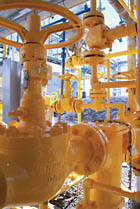Adapting Industrial Maintenance Coatings to Accommodate an Ever-Changing World

As we all know, change is just a part of life. No one knows this better than paint formulators who have dealt with many changes in their market for the last few years. In the past, formulators focused on making sure their customers were satisfied by providing coatings that had consistent performance, durability, proper application viscosity, long-lasting substrate protection, and were aesthetically pleasing. Consumers want all of that, as well as low prices.
Now, in addition to performance requirements, there are various government regulations that have an impact. Environmental concerns have required formulators to remove certain additives that are considered harmful to the eco system and/or are suspected of having adverse health effects. As a result, the paint is reformulated to meet government regulations and customer needs.

Long-Term Performance
One of the important additives for Industrial Maintenance (IM) coatings is plasticizers. Plasticizers help to maintain film flexibility throughout the many thermal cycles that a coating experiences during its service life. Without the plasticizer the coating would become brittle and crack as the substrate expanded and contracted during hot and cold cycles of the seasons. The paint must withstand not only direct sunlight and the blistering summer heat, but also freezing rain and cold of the winter seasons. If the coating cracks, then the substrate is no longer protected from the outside elements. The substrate will then begin to deteriorate at the point where the film cracked, leading to delaminating of the coating which, in turn, leads to further deterioration of the substrate. This cycle leads to expensive repairs of the structure that the coating was developed to protect.In a perfect world the coating would never fail, but the environment to which a coating is subjected day after day is anything but perfect. The paint formulator must determine which additive will perform the best while producing a coating that will meet both the customer needs and regulatory requirements.

In recent years, however, ortho-phthalate plasticizers such as BBP and DBP have become targets of consumer groups that have demanded the removal of these additives in products that range from toys to coatings. On December 2, 2005, the California Office of Environmental Health Hazard Assessment (OEHHA) added BBP and DBP, along with di-n-hexyl phthalate (DnHP) to the Proposition 65 list of chemicals as being "known to the state to cause reproductive toxicity," prompting manufacturers to seek alternative products.


New Product Development
Raw material suppliers are developing new products every day to help paint formulators meet both performance and regulatory demands. As an example, one recently introduced material, Optifilm Enhancer 400, offers the best of both worlds. It is a nonphthalate alternative with a similar boiling point (Table 1) that is compatible with both solvent- and waterborne systems. In addition, it can help formulators meet a number of environmental regulations (Table 2).Another benefit of this type of additive is that it not only keeps the films flexible but it also aids in film formation of latex systems (Table 3). This is an important benefit to formulators who are under constant pressure to reduce the VOC in their coatings. Additives such as co-solvents, thickeners, preservatives and lower-boiling plasticizers can add to the VOC level of the coating. As a coalescent, Optifilm Enhancer 400 efficiently decreases the minimum film formation temperature (MFFT) of a variety of latexes while making very little contribution to the VOC of the coating. High-boiling plasticizers like DBP and BBP will also reduce the MFFT of the latexes but with varying efficiency.

Formulating with Optifilm 400
Naturally, it is important that an alternative product allows the formulator to maintain the overall physical properties of the coating, and care must be exercised not only in selection but also in the amount of the product used in the paint. For example, in a solventborne lacquer formula the films were softer when Optifilm Enhancer 400 was used at equivalent levels to the ortho-phthalate plasticizers, suggesting that it is more efficient. Subsequent testing of two more coatings formulated with reduced levels of Optifilm Enhancer 400 showed that the hardness value increased with reduced levels of Optifilm Enhancer 400 while the flexibility remained constant (Table 4).The Optifilm Enhancer 400 and the ortho-phthalate plasticizers were also evaluated for flexibility and hardness in a waterborne system. The results were similar for all three systems (Table 5). The waterborne paints were also submitted for Prohesion testing for corrosion resistance. Under the severe conditions of this test, all of the paints exhibited the same amount of blisters and rust on the surface after 500 hours exposure.
Having a choice of solutions is important for paint formulators when it comes to selecting the raw materials in their paint. Government regulations and consumer concerns have forced the formulator to become more selective in his/her choice of paint additives. Optifilm Enhancer 400 allows paint chemists to continue meeting the needs of their customers and the requirements of regulatory agencies.
Looking for a reprint of this article?
From high-res PDFs to custom plaques, order your copy today!



